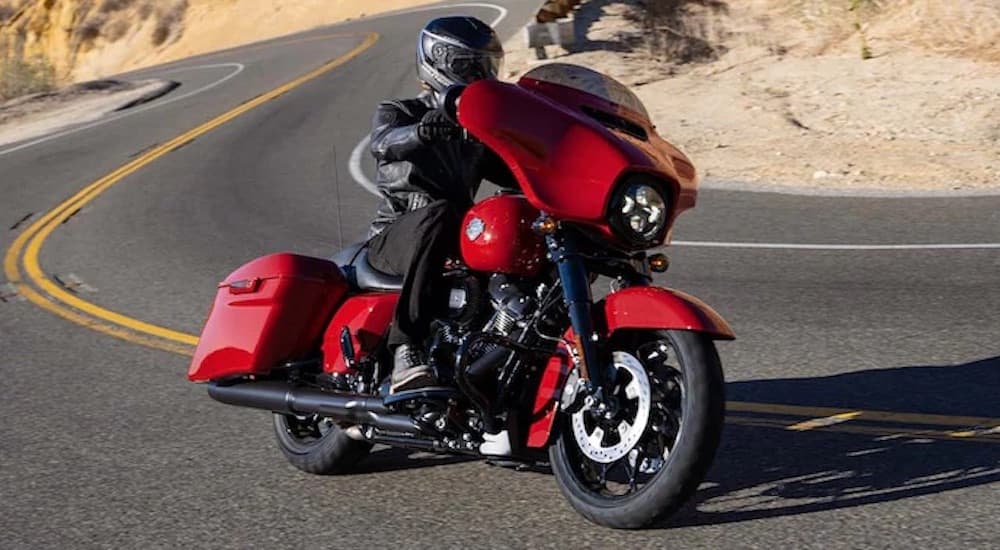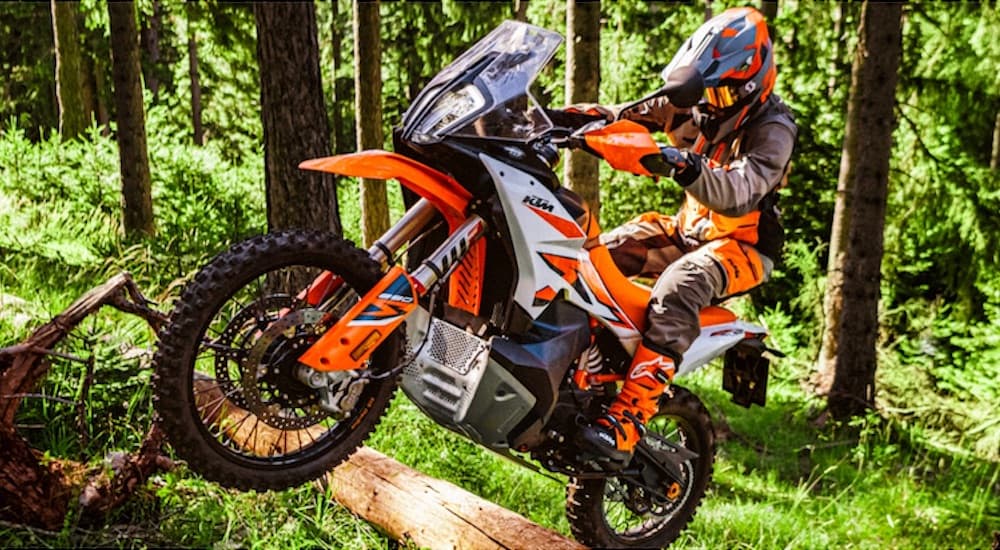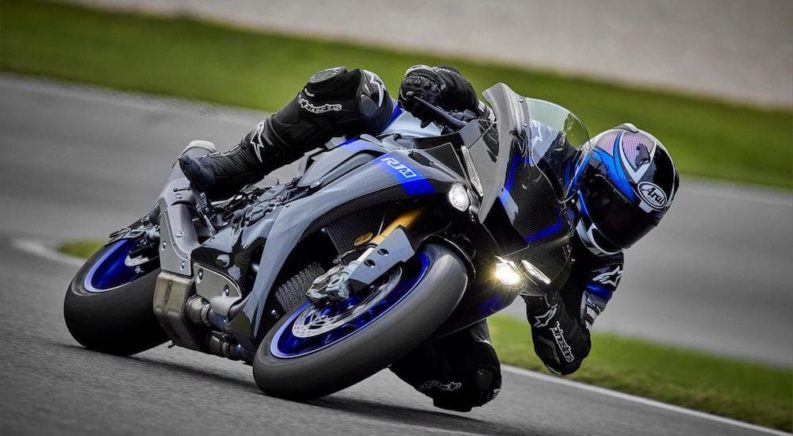Riders love to customize their motorcycles, laboring over the right mods, accessories, and upgrades until the cows come home. But if you’re looking for the single component that has the most dramatic effect on overall ride quality, safety, and enjoyment, motorcycle tires should be at the top of your list. The right set of treads can make the difference between a successful ride and one that ends in disappointment, so we thought it might be helpful to cover some of the basics when it comes to motorcycle tires. Unlike the tires you will find on a car, truck, or SUV, motorcycle tires can be very specific to a certain type of bike. The differences go well beyond size, with each type of motorcycle requiring tires of a certain design and construction. Let’s take a look at some of the most common types of motorcycle tires and see how each one is purpose-built to deliver the ideal blend of comfort, control, and safety.
#1 – Sport Tires
Sport tires are specifically designed for use on lightweight sport bikes and high-performance street bikes. Their unique construction maximizes handling, providing a nimble, precise tire with amazing edge-to-edge grip. These tires are typically lighter than other motorcycle tires and are made with softer compounds in order to maximize traction. They also tend to have a more rounded shape with a prominent center line, which is helpful when it comes to transitions from side to side and allows riders to lean into turns in a way that would prove disastrous on more traditional types of motorcycle tires.
These tires are built using stiffer radial construction, which improves support and stability while also addressing the heat dissipation required for high-speed braking and cornering. Unlike some motorcycle tires, sport tires usually have less aggressive tread patterns in order to deliver a larger contact patch. While this does hamper their ability to perform in wet weather conditions, they’re still serviceable as long as the road surface isn’t completely soaked. The softer compound used in sport tires means that they won’t last as long as some other tire types, but when you’re looking to maximize cornering, grip, and control, they can’t be beat. Bikes that benefit from a good set of sport tires include the Honda CBR1000RR, Yamaha YZF-R1, and Suzuki GSX-R1000.
#2 – Touring Tires
Built with longevity and rain-slicked roads in mind, touring tires are a great all-around option for those undertaking longer rides. Made of a much harder compound than sport tires, touring tires don’t offer the same level of grip but make up for it when it comes to overall tread life. Sometimes built with bias-ply construction that includes the use of polyester or fiberglass, touring tires excel at absorbing impacts and providing a smooth ride over long distances.
Unlike sport tires, touring tires are designed to add some much-appreciated straight-line stability to the mix, which helps when it comes to reducing rider fatigue. Plenty of sipes and a generous tread pattern help to wick away moisture from the tire’s contact patch, which is an important factor when it comes to a long ride where riders might encounter a wide range of weather conditions. Bikes like the Harley-Davidson Street Glide, Honda Gold Wing, and BMW K 1600 are all ideal candidates for touring tires.

#3 – Cruiser Tires
While some people tend to clump touring and cruiser tires into a single category, there are some subtle differences between the two types. Cruiser tires tend to be softer and are more likely to have bias-ply construction to produce a more compliant ride. They lack the precise cornering of sport or even touring tires but make up for it when it comes to comfort and wet weather performance. These tires have a deeper tread than many other types and don’t need to support the full weight of a heavy touring bike. Cruiser tires are the go-to option for classic cruiser-style bikes like the Harley-Davidson Softail models, Yamaha Bolt, and Kawasaki Vulcan.
#4 – Sport Touring Tires
Who says touring can’t involve some high-performance fun? Toeing the line between sport and touring tires, sport touring tires off the best of both worlds. Perfect for riders who are looking to maximize both traction and mileage, sport touring tires are a useful alternative for longer rides on high-performance bikes. It all comes down to their unique construction, which uses softer rubber compounds on the side to increase grip when cornering, but balances that out with harder compounds towards the center of the tire in order to improve both stability and longevity.
Even if there isn’t any long-distance touring in your future, sport touring tires offer a more economical alternative for sport bike riders looking to extend their tread life and reduce their tire budget. Sport touring tires are also a much better alternative to pure sport tires when it comes to wet, rainy conditions, allowing the ride to continue even when the clouds start to gather. Bikes like the Yamaha FJR1300, Kawasaki Concours 14, and the BMW R 1250 are all a good fit for sport touring tires.
#5 – Dual Sport/ADV Tires
If your typical ride involves a healthy mix of paved and off-road surfaces, dual sport/ADV tires might be just what you’re looking for. These tires are smooth enough for comfortable riding on paved roads but have the knobby ridges necessary to grip dirt, sand, mud, rocks, and other challenging surfaces you might encounter on your off-road journey. The treads are outfitted with prominent blocks, which not only improve traction but also allow the tires to self-clean, flinging dirt away and allowing you to maintain your grip on the trail.
That said, not all dual sport/ADV tires are created equal. In fact, they can vary drastically as the category encompasses a wide range of designs catering to specific mixes of on and off-road usage. For example, many dual sport/ADV tires are listed as “70/30”, meaning they’re designed to spend 70 percent of their time on paved roads and 30 percent on the trail. A 50/50 tire will feature more prominent ridges and blocks if you’re looking for a more well-rounded option. This might hinder on-road performance but will deliver more traction in dirt and mud. On the opposite end of the spectrum, a 90/10 tire will prove easy to ride on the road but still give you some grip on the trail. Dual sport/ ADV tires work well on bikes like the KTM 1290 Super Adventure and Honda Africa Twin.

A Tire for Every Niche
When it comes to motorcycle tires, there are plenty of distinct designs to serve every niche. From grippy, nimble sport tires to stolid cruiser tires and adaptable dual sport/ADV options, each tire offers a unique mix of tread life, grip, control, and precision. In most cases, the type of tire you land on is going to be determined by your specific bike. But while you’d never put knobby-off road tires onto a sport bike––or vice versa––it never hurts to understand the differences and familiarize yourself with all the different types of motorcycle tires on offer. That said, some riders might find it worth exploring the difference between cruiser, touring, and sport touring tires, which can have a big impact on overall ride quality and enjoyment. It’s important to remember that no matter how powerful a motorcycle might be, the tires are where the rubber meets the road and should never be treated as an afterthought.

